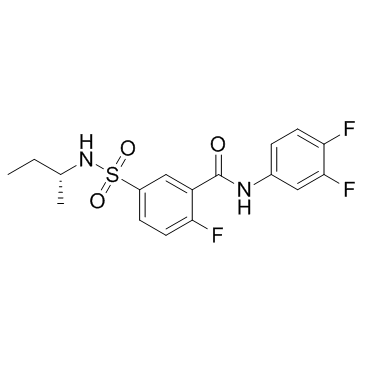| Description |
AB-423 is an inhibitor of HBV capsid assembly, and potent inhibits HBV replication with EC50/EC90 of 0.08-0.27 μM/0.33-1.32 μM in cells.
|
| Related Catalog |
|
| Target |
HBV capsid[1]
|
| In Vitro |
AB-423 is an inhibitor of HBV capsid assembly. AB-423 shows inhibitory effect on rcDNA production in AML12-HBV10 and HepDE19 cells with EC50s of ∼0.260 μM. AB-423 also suppresses cccDNA formation-dependent HBeAg production in the HepBHAe82 assay with an EC50 of 0.267 μM and inhibits HBV DNA levels in culture supernatants of HepG 2.2.15 cells with an EC50 of 0.134 μM. However, AB-423 has no cytotoxicity in any of the three cell lines[1].
|
| In Vivo |
AB-423 (30 and 100 mg/kg, p.o. bid) blocks HBV replication in a mouse model of HBV. AB-423 (100 mg/kg, p.o. bid) with entecavir (ETV, 100 ng/mg, qd, p.o.) or 0.1 mg/kg dose of ARB-1467 potently inhibits serum HBV DNA in an HDI model of HBV in immunodeficient NOD-SCID mice[1].
|
| Cell Assay |
To test the compound combinations, HepBHAe82 (50,000 cells/well) are plated in 96-well tissue-culture treated microtiter plates in DMEM/F12 medium supplemented with 10% fetal bovine serum, 1% penicillin-streptomycin and tetracycline (1 μg/mL), and incubated in a humidified incubator at 37°C and 5% CO2 overnight. On the next day, the cells are switched to fresh medium and treated with inhibitor A and inhibitor B, at concentration range in the vicinity of their respective EC50 values. The inhibitors are either diluted in 100% DMSO (ETV, TDF and AB-423) or growth medium (ARB-1467 and ARB-1740) and the final DMSO concentration in the assay is ≤0.5%. The two inhibitors are tested both singly as well as in combinations determine their effects on inhibition of rcDNA production. The final DMSO concentration in the assay is 0.5%. The plates are incubated for 9 days in a humidified incubator at 37°C and 5% CO2. Following a 9 day-incubation, medium is removed, and cells are subjected to RNA extraction to measure the cccDNA-dependent precore mRNA level[1].
|
| Animal Admin |
Mice[1] Prior to start of treatment, 10 micrograms of the plasmid pHBV1.3 is administered to NOD.CB17-Prkdcscid/J mice via hydrodynamic injection (HDI; rapid high volume injection into the tail vein; n = 6 to 8 animals per group). This plasmid carries a 1.3-fold overlength copy of a HBV genotype D genome which, when expressed, generates hepatitis B viral particles and other HBV products. AB-423 is administered via oral gavage at 30 or 100 mg/kg twice-daily for 7 consecutive days, starting on Day 0. Entecavir (ETV) at 100 ng/kg once-daily for 7 consecutive days, starting on Day 0. ARB-1467 is administered as a single intravenous bolus tail vein injection at 0.1 mg/kg on Day 0. Blood is collected on Days 0 (pre-dose), 4 and 7 for HBV biomarker analysis. Serum HBV DNA concentration in mice is measured from total extracted DNA using a quantitative PCR assay using primer/probe sequences[1].
|
| References |
[1]. Mani N, et al. Preclinical profile of AB-423, an inhibitor of Hepatitis B virus pgRNA encapsidation. Antimicrob Agents Chemother. 2018 Mar 19.
|
